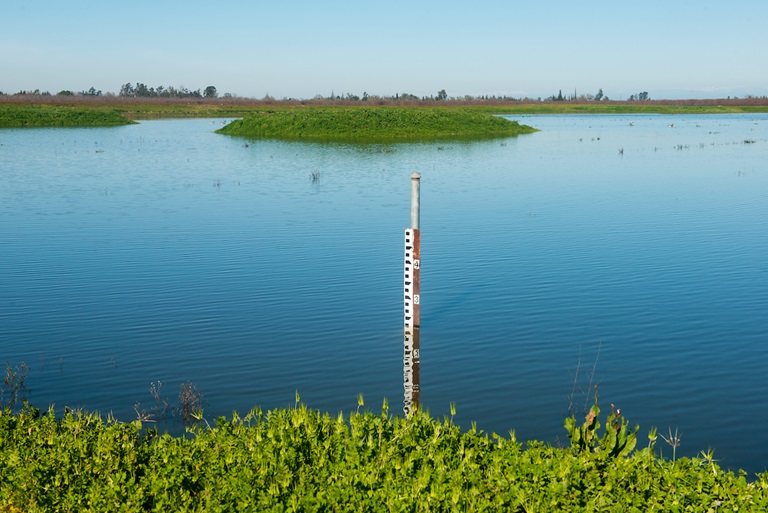Working Together is Key to Protecting Groundwater
Groundwater recharge ponds located on the grounds of the Stockton East Water District (SEWD).
By Paul Gosselin (first appeared in Ag Alert, the agricultural newspaper published by the California Farm Bureau)
Nearly eight years ago, during our last severe drought in 2014, the California Legislature took bold action to enact landmark groundwater legislation known as the Sustainable Groundwater Management Act (SGMA). Less than a decade later, the West is experiencing continued historic drought impacts that have researchers claiming this to be the most gripping drought in over 1,200 years.
While they may be out-of-sight and underground, California’s groundwater basins are a critical part of our state’s water supply, providing about 40% of the state’s supply in average years and up to 60% in dry years, like the severe drought conditions we’re currently experiencing.
Millions of people across the state depend on groundwater for their drinking water, business, and irrigation needs. Much of California’s vibrant agricultural production relies on groundwater. The sustainability of California’s groundwater is critical to California agriculture, communities, and environment.
The SGMA legislation set forth a long-term groundwater management framework—it enacted a 20-year timeline to achieve groundwater sustainability based on local control. Local, public groundwater sustainability agencies (GSAs) are entrusted to improve groundwater management through new authorities, including being tasked with developing the first-ever groundwater sustainability plans as the pathway to reach local sustainability goals.
Between 2020 and 2022, a major milestone was accomplished under SGMA when all of the required groundwater basins, nearly 100 basins, submitted their first plans to the Department of Water Resources (DWR) for evaluation. In January 2022, DWR completed evaluations of plans in 20 of the most critically overdrafted basins, approving eight basins and deeming 12 basins incomplete.
These first plans were not perfect but rather works-in-progress. Under its role to evaluate plans, DWR found that relevant data and information were missing from some of these plans and asked local agencies to provide additional justifications and fill data gaps.
Revisions to these early plans were necessary to set the foundation for sustainability through science-based decision-making that will improve the overall understanding of these complex groundwater systems to provide a drought resilience future.
The 12 basins with incomplete plans, located in the San Joaquin Valley, have 180 days—until the end of July 2022—to correct and resubmit their plans. DWR will host a 60-day public comment period on the resubmitted plans and re-evaluate whether the plans substantially comply with the law.
DWR’s decision will be one of two options for these basins—either approved or inadequate. If DWR determines a basin to be inadequate, the State Water Resources Control Board will step in as the State backstop through a process called intervention. However, the goal of any state intervention will always be to transition groundwater management back to local control.
DWR continues to evaluate plans in the remaining nearly 80 basins that have plans or an alternative to a plan currently under review. On an ongoing basis, DWR will review regular five-year plan updates, monitor progress annually, and continue to support locals through planning, technical and financial assistance.
Since local control is one of the founding cornerstones of the Sustainable Groundwater Management Act, local agencies are expected to continue working with all groundwater users in their basins, including landowners, farmers, community-based organizations, domestic well users, and underserved communities. All perspectives are valuable, and diverse interests must be considered as part of the local decision-making processes.
All plans whether approved, incomplete or under review are being implemented by local agencies. They are advancing efforts toward groundwater sustainability. In May, DWR awarded over $140 million to critically overdrafted basins to support implementation.
Groundwater recharge programs are a major component of implementation. Groundwater basins serve as natural underground water storage infrastructure with the capacity to hold an estimated eight to twelve times the amount of water as our surface storage reservoirs.
Recognizing that groundwater conditions have changed over decades and a hotter, drier climate is accelerating the need to conserve water and convey and store water when it is available, plans will need to adapt over time in order to reach sustainability through local control, wise management, and cooperative coordination.
Local agencies continuing to implement projects and actions will be critical for long-term water resilience in the coming decades of SGMA implementation. Local control and public involvement are important for successful outcomes to be achieved. The public and interested parties are encouraged to be informed and stay engaged.
All of us must work together to reach a sustainable groundwater future.
(Paul Gosselin is deputy director of the Sustainable Groundwater Management office at the California Department of Water Resources. He may be contacted at sgmps@water.ca.gov.)
